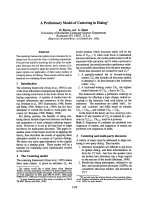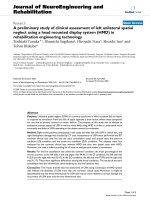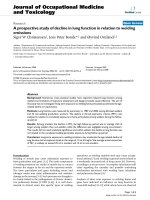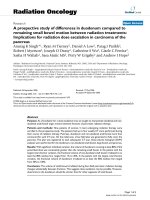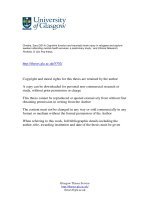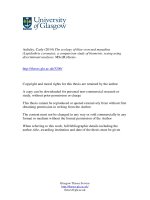A PRELIMINARY STUDY OF ROOT TO SHOOT REGENERATION BY ECTOPIC EXPRESSION OF WUS IN ARABIDOPSIS THALIANA ROOTS
Bạn đang xem bản rút gọn của tài liệu. Xem và tải ngay bản đầy đủ của tài liệu tại đây (2.02 MB, 117 trang )
A PRELIMINARY STUDY ON ROOT-TO-SHOOT
REGENERATION BY ECTOPIC EXPRESSION OF
WUSCHEL IN ARABIDOPSIS THALIANA ROOTS
ZHANG SHUAIQI
NATIONAL UNIVERSITY OF SINGAPORE
2011
A PRELIMINARY STUDY ON ROOT-TO-SHOOT
REGENERATION BY ECTOPIC EXPRESSION OF
WUSCHEL IN ARABIDOPSIS THALIANA ROOTS
ZHANG SHUAIQI
(B. Sci.)
A THESIS SUBMITTED
FOR THE DEGREE OF MASTER OF SCIENCE
DEPARTMENT OF BIOLOGICAL SCIENCES
NATIONAL UNIVERSITY OF SINGAPORE
2011
i
ACKNOWLEDGEMENTS
During the two passed years of my research life, many persons have helped,
encouraged, and supported me. It was a precious memory and an opportunity for me to
involve in the scientific career.
First, I wish to thank my helpful supervisor, Assistant Professor Xu Jian, who is a
young scientist and will be one of the greatest scientists in plant root area. Dr. Xu was quite
nice and helpful during the last two years. He guided me to start the research in plant field.
Since I once had no previous experience about plant research and sometimes I cannot figure
out the problems of my research, he advised me a lot in my research period. He is also very
smart in the research direction. Once when I don’t know where my research will go, he can
always help me find the correct direction. In the meantime, he always helps me find different
kinds of transgenic plants and mutant lines which will be useful in the future. Moreover, Dr.
Xu is also quite concerned about my life in Singapore. When I became a fresh post-graduate
student in National University of Singapore, he helped me adapt to the life here.
Second, I wish to thank my family. They had supported me a lot during my
undergraduate life in China and my graduate life in Singapore. During the last two years, I
only stayed with my parents a few days. It was quite regretful for the past period. But for the
future, I will try my best to stay with my parents as long as I can. Also, I wish to thank my
wife who has supported my every decision. Although our future life still has many
uncertainties, I think we will overcome the difficulties and embrace the bright future.
Third, I wish to thank my colleagues, Yanbin, who has helped me learn the basic
experiment techniques which are very useful during my research life, Ximing, who has
helped me find the direction of my research and solve the problems which I have met,
Huangwei, who has advised me some new directions although I have no more time to
ii
perform these techniques, Seng Wee, who has given me some useful suggestions, Yanfen,
who has helped me solve some molecular cloning problems. And I also wish to thank Jing
Han, Zhang Chen, Wang Juan, Peck Ling for their helps in my research life. Without all the
helps from my colleagues, I am sure my research will be very difficult.
Fourth, I wish to thank my friends from my neighbors, Qinghua, who has helped me
settle down in Singapore and share the boring weekend with me, Haitao, Zikai, Bingqing,
Xiaoyang, Dr Niu, Wen Yi, Ruimin, Zhicheng, Shichang, and so on. There are too many
friends I have obligated to thank. It is a sad thing that I cannot thank all the people who have
helped me.
Last but not the least, I wish to thank my examiners, Professor Wong Sek Man and
Assistant Professor Lin Qingsong, for their insight guidance in the pre-thesis examination and
the future work.
Finally, I would thank the National University of Singapore for awarding me a research
scholarship to support my studies in this interesting project and life in Singapore.
iii
TABLE OF CONTENTS
Acknowledgements i
Table of Contents iii
Summary vi
List of Tables viii
List of Figures ix
List of Abbreviations xi
Chapter 1 Introduction 1
1.1 Overview of regeneration 1
1.1.1 Regeneration in polyps 1
1.1.2 Regeneration in other animal and plant systems 1
1.1.3 Differences and similarities in regeneration between animal and plant systems 1
1.1.4 Difficulties in in vivo studies of regeneration 2
1.2 Regeneration in the plant field 3
1.2.1 Root apical meristem and shoot apical meristem in plants 3
1.2.2 Regeneration of a new root tip 4
1.2.3 Regeneration of a new quiescent centre in the root 4
1.2.4 Induced shoot buds from in vitro cell culture 5
1.2.5 The structure of shoot apical meristem 6
1.2.6 The WUS/CLV pathway 6
1.2.7 Regeneration caused by ectopic expression of WUS 7
1.2.8 Regeneration caused by ectopic expression of other transcription factors 8
1.2.9 Regeneration in Alfalfa 8
1.2.10 Regeneration in Poplar 9
1.3 Aims of this study 10
iv
Chapter 2 Methods and materials 13
2.1 Plant growth condition 13
2.2 Seeds sterilization and plating 13
2.3 RNA extraction 14
2.4 cDNA preparation 15
2.5 Plasmid construction 16
2.6 Agrobacteria transformation and plant transformation 18
2.7 Plant selection 19
2.8 Confocal microscopy 19
2.9 DIC microscopy 20
Chapter 3 Molecular cloning and generation of transgenic plants 21
3.1 The glucocorticoid inducible GAL4VP16-GR (GVG)/UAS system 21
3.2 Generation of UAS constructs 23
3.3 Generation of transgenic plants 26
Chapter 4 Studies of ectopic expression of WUS in non-inducible lines 34
4.1 The GAL4-GFP enhancer trap lines 34
4.2 Generation and studies of the non-inducible lines 35
4.2.1 Studies of ectopic expression of WUS in lateral root cap and epidermis 35
4.2.2 Studies of ectopic expression of WUS in columella stem cells 39
4.2.3 Studies of ectopic expression of WUS in lateral root cap and columella
root cap 40
4.2.4 Studies of ectopic expression of WUS in pericycle 44
4.2.5 Studies of ectopic expression of WUS in endodermis 47
4.3 Discussion 52
Chapter 5 Studies of ectopic expression of WUS in inducible lines 53
5.1 The GVG/UAS system and advantages of GVG/UAS system 53
v
5.2 Generation and studies of WUS-inducible lines 54
5.2.1 Generation of GVG lines and WUS-inducible lines 54
5.2.2 Studies of ectopic expression of WUS in columella root cap 55
5.2.3 Studies of ectopic expression of WUS in endodermis 61
5.2.4 Studies of ectopic expression of WUS in cortex 78
5.2.5 Studies of ectopic expression of WUS in quiescent centre 80
5.3 Studies of changes in endodermis, cortex, epidermis when ectopic
expression of WUS in endodermis by specific markers 83
5.3.1 Studies of changes in endodermis when ectopic expression of
WUS in endodermis by pSCR::H2BYFP 83
5.3.2 Studies of changes in cortex when ectopic expression of
WUS in endodermis by pCO2::H2BYFP 85
5.3.3 Studies of changes in epidermis when ectopic expression of
WUS in endodermis by pWER::H2BYFP 87
5.4 Discussion 89
5.4.1 Ectopic expression of WUS in root caused meristem cell fate and shoot
regeneration 89
5.4.2 Can WUS-related homeobox genes lead to organ regeneration? 90
5.4.3 How do auxin and cytokinin cross-talk in the regeneration process? 91
5.4.4 Regeneration in animals 92
Chapter 6 General conclusions and future work 93
6.1. General conclusions 93
6.2. Future work 95
References 97
vi
Summary
In plants, new organs and tissues generate from the meristems. The two main
meristems located in root apices and shoot apices, namely the shoot apical meristem (SAM)
and the root apical meristem (RAM), orchestrate the balance between cell differentiation and
cell division with related regulators. For example, the homeodomain protein WUSCHEL
(WUS) and its counterpart WOX5 are responsible to maintain the stem cell potency in the
SAM and RAM, respectively. WUS is first expressed in the 16-cell embryo within the region
that will develop into embryonic shoot. Ectopic expression of WUS has been shown to induce
somatic embryogenesis, indicating that WUS can promote the embryonic identity.
Intriguingly, when expressed in the root, WUS induces shoot stem cell identity and leaf
development (without additional cues), floral development (together with LEAFY), or
embryogenesis (in response to increased auxin), suggesting that WUS establishes stem cells
with intrinsic identity.
To elucidate the mechanism underlying stem cell formation and regeneration in plants, we
developed a tissue/cell-specific GAL4-GR (GVG)-UAS inducible system to ectopically
express WUS in the Arabidopsis root. UAS::WUS lines have been generated and crossed
with tissue/cell-specific drive lines including pSCR::GVG, pWOX5::GVG, pPIN2::GVG,
and pADF5::GVG. Thus, upon DEX application, WUS expression can be ectopically induced
in specific root tissues/cells. Our induction experiments showed that, with inducible
expression of WUS in pADF5::GVG-UAS::WUS and pADF5::GVG-UAS::WUS-mCherry
lines, seedlings induced by DEX for 6 days exhibited a new cluster of stem cells in the root
cap region. This formation of the new cluster of stem cells also abolished the root cap cell
identity.
Moreover, extended induction of WUS expression in the SCR-expressing root endodermis
induced leaf formation from the position of lateral roots or at the basal end of lateral roots,
vii
suggesting the involvement of a lateral root development program. In order to test whether
ectopic expression of WUS in endodermis is sufficient to induce regeneration, we made an
artificial J shape of pSCR::GVG-UAS::WUS roots. After 4days of induction with J-shape
roots, more leaf primordia formed at the curve of the J shape roots. The lateral root primordia
development was also examined with or without induction of WUS in endodermis. Our
results indicated that with induction of WUS in endodermis the lateral root primordia
development became different since stage III due to the extra cell divisions in the WUS-
inducible lines. In addition, the epidermis, cortex, and endodermis specific markers were
introduced in the pSCR::GVG-UAS::WUS line. The ectopic expression of WUS in
endodermis led to extra cell divisions in endodermis, cortex, and epidermis at somewhat
extent. Out data also indicated some cells in the cortex lost their identity due to ectopic
expression of WUS in endodermis. In the future studies, fluorescence activated cell sorting
and microarray assay will be used to unearth the changes in epidermis, cortex, and
endodermis cell layers and reveal the molecular framework for leaf regeneration in
Arabidopsis roots.
viii
LIST OF TABLES
Talbe 1. Basta selection results of different lines with pG2NBL-UAS::WUS 27
Talbe 2. Basta selection results of different lines with pG2NBL-UAS::BBM 28
Talbe 3. Basta selection results of different lines with pG2NBL-UAS::FAS2 29
Talbe 4. Basta selection results of different lines with pG2NBL-UAS::STM 30
Talbe 5. Basta selection results of different lines with pG2NBL-UAS::WUS-
mCherry 32
Talbe 6. Basta selection results of different lines with pG2NBL-UAS::CLE40 32
Talbe 7. Basta selection results of different lines with pG2NBL-UAS::IAA30 33
ix
LIST OF FIGURES
Fig. 3.1. Molecular cloning of pG2NBL-UAS::WUS construct 25
Fig. 4.1. Studies of the changes in root tips with or without expression of WUS
in lateral root cap and epidermis 37
Fig. 4.2. Studies of the changes in root with or without expression of WUS in
columella stem cells 40
Fig. 4.3. Studies of the changes in root tips with or without expression of WUS
in columella root cap 43
Fig. 4.4. Studies of the changes in roots with or without expression of WUS in
pericycle 45
Fig. 4.5. Studies of the changes in lateral roots with or without expression of
WUS in pericycle 46
Fig. 4.6. Studies of the changes in roots with or without expression of WUS
in endodermis 49
Fig. 4.7. Studies of the changes in lateral roots with or without expression of
WUS in endodermis 50
Fig. 5.1. Studies of ectopic expression of WUS in columella root cap 56
Fig. 5.2. Studies of ectopic expression of WUS-mCherry in columella root
cap 58
Fig. 5.3. Studies of confocal microscopy images of extopic expression of
WUS-mCherry in columella root cap 59
Fig. 5.4. Phenotype studies of ectopic expression of WUS in endodermis 62
Fig. 5.5. Long-term effects of induction of WUS in endodermis 64
Fig. 5.6. Three main types of primordia in lateral root region by induction
of WUS in endodermis 65
Fig. 5.7. Phenotypes in lateral root region by induction of WUS in
endodermis with J-hook in root tips 67
x
Fig. 5.8. Confocal images of primary roots with induction of WUS
expression in endodermis 69
Fig. 5. 9. Morphological changes during lateral root development 71
Fig. 5.10. Confocal images of different stages of lateral root primordia
development 73
Fig. 5.11. Confocal images of different stages of lateral root development
with induction of WUS in endodermis 74
Fig. 5.12. DIC images of different stages of lateral root development 76
Fig. 5.13. Phenotype studies of long-term treatment with DEX 77
Fig. 5.14. Studies of the cortex cells with or without expression of WUS
in cortex by DEX 79
Fig. 5.15. Studies of the QC cells with or without expression of WUS in
QC by DEX 81
Fig. 5.16. Long-term studies of the QC cells with or without expression
of WUS in QC by DEX 82
Fig. 5.17. Assay of endodermis layer by an endodermis specific marker
(pSCR::H2BYFP) with DEX treatment 84
Fig. 5.18. Assay of cortex layer by a cortex specific marker
(pCO2::H2BYFP) with DEX treatment 86
Fig. 5.19. Assay of epidermis layer by an epidermis specific marker
(pWER::CFP) with DEX treatment 88
xi
LIST OF ABBREVIATIONS
A adenosine
AD activating domain
BD binding domain
bp base pair(s)
C-terminal carboxyl terminal
C cytidine
CDS coding sequence
CFP cyan fluorescent
protein
DEX dexamethasone
DNA deoxyribonucleic acid
dNTP deooxyribonucleoside
triphosphate
FACS Fluorescence Activated
Cell Sorting
g grams or gravitational
force
G guanosine
GFP green fluorescent protein
GR glucocorticoid receptor
GUS beta-glucuronidase
h hour(s)
kb kilobase(s) or 1000 bp
M molar
MES 2-[N-morpholino]
ethanesulfonic acid
mg milligram(s)
μ micro-
μm micrometer
min minute(s)
ml milliliter(s)
mM millimole
N any nucleoside
N-terminal amino terminal
Oligo oligodeoxyribonucleotide
PPT phosphinothricin
RFP red fluorescent
protein
RNA ribonucleic acid
rpm revolutions per minute
s second(s)
T thymidine
UAS Upstream Activation
Sequence
μl microliter(s)
w/v weight per volume
wt wild type
YFP yellow fluorescent
protein
1
Chapter 1 Introduction
1.1 Overview of regeneration
1.1.1 Regeneration in polyps
In 18
th
century, it was believed that only plants and several microscopic animals have
the ability of regeneration. A scientist named Abraham Trembley discovered, over 260 years
ago, that the freshwater polyps could grow into two new polyps if the old polyp was cut into
two pieces (Trembley, 1744). This study clearly indicated that the freshwater polyps had the
ability in regeneration.
1.1.2 Regeneration in other animal and plant system
The extraordinary discovery demonstrated by Trembley the ability of regeneration in
polyps triggered studies in other species by Bonnet (Bonnet, 1779) and Spallanzani (Bonnet,
1779). The ability of regeneration among the metazoans, including earthworms, snails, newts
and salamanders, was discovered. Investigations by Sachs (Sachs, 1893) and Goebel (Goebel,
1898) in late 19
th
century showed that the whole plants could be developed from the cleaved
pieces of leaves of pansies and begonias.
1.1.3 Differences and similarities in regeneration between animal and plant systems
These studies suggested that there was a clear difference of regeneration in animal and
plant kingdom, where in animals the regeneration process could replace the missed parts
2
while in plants a complete individual could arise from a piece of plant materials. Although
there are differences in regeneration process, the research in plant and animal kingdoms still
led to hypothesis that the underlying mechanisms controlling regeneration in plants and
animals are probably conserved. The regeneration process must contain two basic processes:
(1) acquisition of cellular competence to develop into new organs through cell
dedifferentiation or by taking advantage of the previous totipotent cells; and (2)
reorganization of the regenerative parts from the severed pieces (Birnbaum and Sanchez
Alvarado, 2008). Therefore, it will be interesting to understand the precise steps of
regeneration and the factors controlling these steps. Also, understanding the specific stages of
the regenerative process both in plants and animals will help to explain the underlying
mechanisms of regeneration in both kingdoms.
1.1.4 Difficulties in in vivo studies of regeneration
Despite intensive efforts for gaining a detailed knowledge of the principles of
regeneration in multicellular organisms, little is known about the precise molecular and
cellular basis controlling the regeneration process. This has mainly been due to an inability to
carry out in vivo studies in the species that have traditionally been used to study regeneration.
To overcome this shortcoming, diverse well-established model systems, such as zebrafish,
chicks and mice, are currently being used thanks to recent methodological advances, and are
beginning to reveal the forces that guide the regeneration and those that prevent it (Davenport,
2005; Sanchez Alvarado and Tsonis, 2006). These vertebrate systems, however, typically
only have modest regeneration ability to replace certain missing tissues. In contrast, the
ability to regenerate organs or even a whole plant is wide-spread in the plant kingdom,
3
including Arabidopsis thaliana, a small weed that now serves as a model for understanding
approximately 250,000 other more complex plants.
1.2 Regeneration in the plant field
1.2.1 Root apical meristem and shoot apical meristem in plants
What will the world be if human did not exist? Certainly, the city would be replaced by
plants and animals. Plants would grow in every corner they could. Plants face many kinds of
problems: (1) the leaves can be eaten by animals; (2) the branch can break off the tree; (3) the
roots may be cut off, etc. These undetermined conditions enforce that the plants must rely on
an indeterminate body plan, which is that the number of plant organs is not predetermined, to
generate responses to environment conditions (Dinneny and Benfey, 2008). In plants, there
are mainly two kinds of meristem which are the proliferative tissues located at the growing
apexes. In the shoot, the shoot apical meristem (SAM) is responsible to generate lateral
organs such as leaves, flowers and stalk. The root apical meristem (RAM) plays a more
specific role, generating differentiated cells which support the growth of the root. Both SAM
and RAM are maintained by a specific population of stem cells located in the inner part of the
meristematic regions. Stem cell niches constitute the microenvironment that maintains the
stem cells by certain developmental signals and stem cell factors (Scheres, 2007). Although
there are the structural differences of the shoot apical meristem and root apical meristem, the
two share some common characteristics. In the Arabidopsis root tips, the stem cells that
surround a small group of four organizing cells that rarely undergo cell division, termed the
quiescent centre (QC) cells, give rise to distal (columella), lateral (lateral root cap and
epidermis) and proximal (cortex, endodermis and stele) cell types. In shoot tips, a zone of
three layers of stem cells which consists central zone and peripheral zone is maintained by an
4
underlying organizing centre (OC) which provides signals and acts as the control of stem
cells.
1.2.2 Regeneration of a new root tip
What will happen if the whole root tip is cut off? Using the root-tip regeneration
system in Arabidopsis, it was shown that respecification of lost cell identities began within
hours after excision and that the function of the specialized cells was restored within one day
(Sena et al., 2009). The quiescent centre, all surrounding stem cells along with several tiers of
daughter cells, and root cap including all the columella and most of the lateral root cap were
completely removed by standard excisions at 130 μm from the root tip. The new regenerative
organs formed completely after 7 days of excision.
1.2.3 Regeneration of a new quiescent centre in root
Through laser-assisted ablation experiments, Ben Scheres’ group has discovered the
signaling roles of the quiescent centre in the root stem cell niche. One significant finding is
that the existence of quiescent centre can inhibit the cell differentiation of the surrounding
cells. Once the quiescent centre was laser ablated, the adjoining stem cells went into
differentiation and an auxin maximum recovered and promoted the establishment of a distal
organizer (Sabatini et al., 1999; van den Berg et al., 1997) and the surrounding stem cells
triggered a local regeneration response which eventually led to the regeneration of a new root
tip (Xu et al., 2006). Laser ablation of quiescent centre cells disrupted the flow and
distribution of auxin in root tips. The new quiescent centre could be reoccurred in several
days after the ablation of the previous quiescent centre. This regeneration study showed
5
important roles for the auxin-responsive AP2/EREBP (APETALA2/ethylene responsive
element binding protein) family transcription factors PLETHORA1 (PLT1) and PLETHORA2
(PLT2) (Aida et al., 2004), and the GRAS family transcription factors SCARECROW (SCR)
(Di Laurenzio et al., 1996) and SHORTROOT (SHR) (Helariutta et al., 2000) in root stem cell
respecification and root regeneration, and provided a regeneration mechanism in which
embryonic root stem cell factors respond to and stabilize the distribution of the key
phytohormone, auxin, with roles in developmental patterning. Such feedback mechanisms
between transcription factors action and auxin distribution may also occur during normal
development (Blilou et al., 2005). Thus, like in animals, stem cell respecification and organ
regeneration in Arabidopsis roots are achieved through the combinational activity of
transcription factors. Notably, these transcription factors are members of two plant-specific
families, and their activities are intimately linked to local accumulation of the plant hormone
auxin, indicating that the exact pathways used to activate regeneration in plants and animals
may be specific to each kingdom. Now, the issue arises to what extent regeneration
mechanisms have been conserved among different plant organs.
1.2.4 Induced shoot buds from in vitro cell culture
The natural ability of roots from many species to form buds that develop into new
shoots has been long recognized (Holm, 1925; Raju et al., 1966; Wittrock, 1884). New shoot
buds can be induced from roots or root-derived explants (Gordon et al., 2007; Sugimoto et al.,
2010; West and Harada, 1993), raising the question of how new organs with different cell
lineages and tissue organization are generated within and functionally integrated with existing
organs. To address this question, which is also central to regenerative studies in animals, it is
important to explore the molecular and cellular mechanisms that underlie the pluripotency of
6
differentiated or partly differentiated plant cells which enables them to coordinate a new
pattern of differentiation.
1.2.5 The structure of shoot apical meristem
The ability of self-renewed shoot meristem is necessary for plants which need
repetitive initiation of shoot structures including flowers and leaves during plant development.
Previous studies suggest that the shoot meristem is composed of three zones: (1) the central
zone located at the shoot apex which contains undifferentiated stem cells that supplement the
cells differentiated into primordia initiation cells; (2) a zone underneath (rib meristem) which
forms the skeleton of the shoot axis; (3) the peripheral zone (flank meristem) in which leaf
and flower primordia initiation occurs with rapidly cell division (Steeves and Sussex, 1989).
There are three generative layers in the central zone of the Arabidopsis shoot meristem. The
rib zone is the organizing centre (OC) of the shoot apical meristem which contains the stem
cells that have the full ability to differentiate into the cells of the central zone. The
WUSCHEL (WUS) gene encodes a homeodomain protein which expressed in the organizing
centre (OC) (Gordon et al., 2007; Laux et al., 1996; Mayer et al., 1998). The wus mutants
repetitively initiated defective shoot apical meristems, which led to only a few leaves and
discontinued primordia initiation. This mutant eventually showed early terminated flowers.
The flowers of this mutant were much fewer compared with wild type and developed into a
single central stamen (Laux et al., 1996).
1.2.6 The WUS/CLV pathway
Several other mutants have shown the shoot apical meristem structure and function are
disrupted. Nearly two decades ago, three genes were discovered with defects in shoot
meristem: CLAVATA1 (CLV1), FASCIATA1 (FAS1) and FASCIATA2 (FAS2) (Leyser and
7
Furner, 1992). The clv1, fas1 and fas2 mutants showed fasciated flat stems associated with
enlarged shoot apical meristems and altered flower development and disrupted phyllotaxy.
Flowers of clv1 mutant not only had increased numbers of organs in all four whorls, but also
had some additional whorls not found in wild type plants (Clark et al., 1993). Similar to clv1
mutants, clavata3 (clv3) mutants also showed enlarged shoot apical meristem even at early
mature embryo stage and enlarged floral meristems and more flowers compared with wild
type (Clark et al., 1995). The CLAVATA2 (CLV2) gene encodes a receptor-like protein with
leucine-rich repeats, and clv2 mutants showed similar phenotypes with clv1 mutants,
indicating they are in the same pathway in regulating shoot apical meristems and organ
development (Jeong et al., 1999; Kayes and Clark, 1998). The enlarged shoot apical
meristems and floral meristems were due to mutations in these genes and accumulation of
CLV3-expressing stem cells. The CLV3 gene encodes a small peptide which is secreted into
the extracellular space. This small peptide acts as a ligand for the CLV1 receptor-like kinase
and transducts the signal of communication between organizing centre and central zone
(Clark, 1997; Fletcher et al., 1999; Laufs et al., 1998). The secreted peptide CLV3 interacts
with the CLV1/CLV2 to maintain the size of the shoot apical meristem. The CLV pathway
restricts WUS expression in the organizing centre to control the size of SAM. In this feedback
pathway, WUS acts as a positive signal to maintain the undifferentiated state while the CLV
acts as the negative signal to regulate the WUS expression (Baurle and Laux, 2005; Gross-
Hardt and Laux, 2003; Wang and Fiers, 2010; Williams and Fletcher, 2005). Induction of
CLV3 expression rapidly downregulates WUS expression, which in turn causes the reduction
in the expression of CLV3 (Muller et al., 2006). Thus, the balance between WUS and CLV3
maintained the size of shoot apical meristem and the balance among the pool of stem cells.
8
1.2.7 Regeneration caused by ectopic expression of WUS
Ectopic induction of WUS expression in Arabidopsis root tips can induce shoot stem
cell identity and leaf development (without additional cues), flower development (together
with LEAFY, which is a key regulator of flower development (Wagner et al., 2004; Weigel
and Nilsson, 1995), or embryogenesis (in response to increased level of auxin) (Gallois et al.,
2004). A Cre-loxP-based mosaic expression system was used to induce WUS expression in
Arabidopsis root tips in a manner of non-cell-autonomous effects of WUS (Gallois et al.,
2002; Mayer et al., 1998). The Cre recombinase which is controlled by a heat-shock promoter
catalyzed excision of a β-glucuronidase (GUS) reporter gene to activate WUS expression
from the widely expressed 35S promoter. After heat shock, WUS expression could be
detected in the Arabidopsis root tips. The ectopic expression of WUS induced CLV3
expression in the root, but the expression of two genes did not coincide in the same cell,
suggesting that the ectopic expression of WUS in root tips induced the shoot stem cell identity.
The root meristem region was disorganized, indicating the ectopic expression of WUS
affected other cells. After three or four days post heat-shock induction, AINTEGUMENTA
(ANT, a marker for shoot organ primordia (Elliott et al., 1996) was also detected, suggesting
these cells display the shoot stem cell identity (Gallois et al., 2004).
1.2.8 Regeneration caused by ectopic expression of other transcription factors
The CLASS III HOMEODOMAIN-LEUCINE ZIPPER (HD-ZIP III) transcription
factors acts as master regulators of embryonic apical fate, and ectopic expression of HD-ZIP
III transcription factors is sufficient to induce a second shoot pole in the root pole region
(Smith and Long, 2010). Ectopic expression of a stable version of REVOLUTA (REV, a HD-
ZIP III transcription factor (Talbert et al., 1995) under the promoter of PLETHORA2 (PLT2)
was able to initiate another shoot pole in the root pole region. Similarly, ectopic expression of
9
some other HD-ZIP III transcription factors, ICU4 and PHB, also induced a second
completed shoot pole (Smith and Long, 2010).
1.2.9 Regeneration in Alfalfa
Regeneration is commonly found in several diploid Alfalfa systems: Medicago
littoralis (Zafar et al., 1995), Medicago lupulina (Li and Demarly, 1995), Medicago murex
(Iantcheva et al., 1999), Medicago polymorpha (Iantcheva et al., 1999), Medicago truncatula
(Iantcheva et al., 1999; Nolan et al., 1989; Trieu and Harrisson, 1996). Alfalfa is the most
important legume forage crop, cultivated across worldwide (Iantcheva et al., 2001).
Regeneration in Medicago truncatula can arise from the potential explant tissues in liquid
media via direct somatic embryogenesis. A rapid transformation and regeneration method in
Medicago truncatula was developed and increased the production dramatically. With 12-day
cultivation of cotyledonary explants on regeneration medium, shoots began to arise from the
cut face of the explants (Iantcheva et al., 2001).
The dramatic regeneration ability in medics raises a question: why do these plants need
this regeneration to reproduce the mother plant? One possible explanation is this regeneration
method provides protection in the environment at their early development stages and
maintains the productivity of the species.
1.2.10 Regeneration in Poplar
The long generation time and seasonal dormancy in Poplar have restricted the demand
of biomass production and wood industry. However, the genetic engineering method has
offered a short-term breeding program. Through in vitro treatment, micropropagation by
proliferation of axillary buds (Peternel et al., 2009; Whitehead and Giles, 1977) or meristem-
tip culture (Rutledge and Douglas, 1988) has been reported in several poplar species. Populus
10
balsamifera, commonly known as P. balsam, is highly flood-tolerant and is able to form
adventitious roots within a few days of a flood. This trait helps it adapt to fire in a forest and
it has the ability to generate sprouts from roots, stumps, and buried branches. The dramatic
regeneration ability in Populus is quite important for the adaption and reproduction of
Populus.
Over-expression of a Populus Class 1 KNOX homeobox gene, ARBORKNOX1 (ARK1),
which is orthologous to Arabidopsis SHOOT MERISTEMLESS (STM), or STM in the cell
cultures developed well-defined shoots with leaves (Groover et al., 2006). Due to the over-
expression of ARK1 or STM which promotes meristematic cell fate and delay terminal
differentiation in both the SAM and the cambium, ectopic meristems forming on the adaxial
side of leaves, inhibition of leaf development, shortening of internode lengths, and delay of
the terminal differentiation of daughter cells derived from the cambium were found in the
over-expression Populus.
Why does Populus need the ability to regenerate in the roots? One obvious advantage
is that the generation time shortens due to no seed dormancy. The regeneration breeding
method has dramatic agricultural importance. New seedlings arise from a piece of the mother
plant, and regenerate into new plants. In agriculture, rapid breeding from pieces of potatoes
guarantees the mass production. This rapid breeding method can also help survive from some
environmental disaster. Fire or storm might destroy the stem of plants, but the regenerative
ability from the roots could facilitate the fast growth of new plants.
1.3 Aims of this study
Though common in nature, the precise underlying mechanisms of regeneration is
largely unknown. Through in vitro cell culture, new seedlings could arise from the explant
tissues in many Medicago and Populus. With continuing over-expression of STM or ARK1 in
Populus, new ectopic meristems form in the explants through in vitro culture.
11
Ectopic expression of WUS in the Arabidopsis root could induce shoot stem cell
activity (Gallois et al., 2004). However, it is not clear how WUS can overwrite the existing
root developmental program even in the presence of master root regulators. Rational
manipulation of WUS expression (tissue or cell-specific, inducible) in a root context will
allow us to dissect at the cellular level how a particular developmental pathway can be
initiated within the growing root tips.
To elucidate the mechanism underlying stem cell formation and regeneration in plants,
we developed a tissue/cell-specific GAL4-GR (GVG)-UAS inducible system to ectopically
express WUS in the Arabidopsis root. In this study, WUS will be cloned and introduced into
Arabidopsis. The UAS::WUS line will then be crossed with non-inducible and inducible
tissue or cell-specific lines. To understand the effect with ectopic expression of WUS in
different tissues, the induction of WUS will be studied.
A combination of newly developed in vivo live imaging techniques, fluorescent marker
lines, fluorescence activated cell sorting (FACS), microarray expression profiling,
regenerative mutant analysis and computational modeling should help us gain a more
comprehensive understanding of regeneration mechanisms in plants. In this study, WUS-
inducible lines will be combined with the epidermis, cortex and endodermis specific markers,
respectively.
Based on these studies, we will be able to address: (1) in which types of tissues or cells
ectopic expression of WUS could induce shoot regeneration; (2) at which time point shoot
regeneration could be started; and (3) how long the induction period of WUS would be
required to induce shoot regeneration.
These studies will reveal novel aspects of root-to-shoot regeneration and the important
roles of key stem cell factors in plant regeneration. In the future, the epigenetic pathways that
control the initiation and reprogramming of regeneration process will be elucidated. The
ability to manipulate tissue, organ or whole plant regeneration will allow us design novel
12
propagation techniques and molecular genetic breeding approaches for horticulture and
agriculture applications. Moreover, the knowledge and information derived from this study
and future studies can be further applied to parallel studies in animals and humans.

